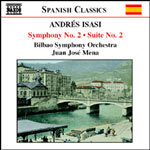
Symphony No. 2, Op. 23 / Suite No. 2, Op. 21
 $25.00
Out of Stock
$25.00
Out of Stock6+ weeks add to cart
ISASI
Symphony No. 2, Op. 23 / Suite No. 2, Op. 21
Bilbao Symphony Orchestra / Juan Josa Mena, conductor
[ Naxos Spanish Classics / CD ]
Release Date: Thursday 1 July 2004
This item is currently out of stock. It may take 6 or more weeks to obtain from when you place your order as this is a specialist product.
Among the more shadowy figures of early twentiethcentury music is Andres Isasi (y Linares). Born in Bilbao on 18th October 1890, he developed a love of music through playing the piano at the house of his grandfather, with whom he went to live after the death of his parents, and studied piano and composition with Unceta. When he was eighteen, two recitals of his Grieg-influenced music were praised by critics and public alike.
Feeling the urge to travel, he moved to Berlin in 1910, attending classes with Karl Kampf and Engelbert Humperdinck, from whom he received extensive instruction in larger symphonic forms. Isasi was already a prolific song composer, but now, especially given the success of works by his older contemporaries Jose Maria Usandizaga and Jesus Guridi, he turned to the symphonic poem as the medium with which to reintroduce himself to Bilbao audiences on his return in 1914.
Response to such overtly Germanic music, however, was lukewarm, and Isasi retreated to the family home in Algorta, where he could compose in relative seclusion. Although his music was performed in Madrid and other Spanish cities during the next decade, he enjoyed greater success abroad, notably in Budapest, where his Second Symphony was heard in 1931. Never in need of money, and a generous supporter of Basque artists working in a variety of media, he continued in his music to reflect his love of German literature, as well as his lifelong religious conviction. His passionate interest in nature is reflected in the 'Ornitofonia' on which he worked for many years: a study of the songs of birds and the many different variants, such as could be used as a resource for his own music. Apart from two symphonies and three orchestral suites, his output includes several symphonic poems, a piano concerto, pieces for piano and for choir, and a large number of songs. He died, largely forgotten, at Algorta on 6th April, 1940.
Isasi's Second Symphony is a large-scale work cast in the traditional four movements. The first movement begins expressively in a manner akin to Strauss or early Scriabin, woodwind and brass sounding dreamily against diaphanous strings. A pause, and the music continues more urgently, giving way to a lilting idea for clarinets over syncopated strings, and reaching a shortlived climax before gradually winding down. Timpani begin the tense development section, mainly concerned with the opening theme and deviating into the minor mode before moving seamlessly into the reprise. The lilting idea is recalled, bringing the movement to a gentle close. Over undulating accompaniment, strings and later woodwind elaborate the Adagio's rather Delian main theme, complemented by a more restive idea begun by cor anglais. Passionate unison chords threaten a stormier mood, but the music continues in its opening vein, passing through a poetic passage for solo woodwind and harp, before the main themes are recalled in slightly varied garb.
The Scherzo begins arrestingly with a spiky idea played pizzicato and col legno by the violins, lower strings and woodwind entering as the movement develops an attractively capricious demeanour. The central trio is more graceful, though elements of the scherzo music are never far away, presaging a full repeat of the first section. The finale begins with a melody of Russian liturgical cast, evolving contrapuntally so that the whole orchestra finally joins in. There follows a full-throated melody for strings and brass, underpinned by sonorous gong strokes, interspersed with reminders of the first idea and leading to an animated discussion on both themes. The first of these is now warmly recalled on lower strings, ushering in an affirmative build-up as before and a repeat of the second theme. The work ends with a brief but triumphal coda.
The Second Suite is closer in style to the symphonic poems with which Isasi made his wider name. The Idyll has a slightly oriental feel, sensuous and mysterious by turns, with only a passing animation to disturb the prevailing calm. The Burleske, which suggests that the composer might have heard some of the lighter music of Sibelius, has a delightful piquancy, not least through some characterful writing for woodwind and a sudden glissando on xylophone. The Fugue brings in solo strings according to time-honoured practice, but, as with the finale of the Second Symphony, the texture is contrapuntal rather than strictly fugal as such. A thoughtful passage for lower strings briefly provides contrast, before a unison statement of the fugue idea ends the piece emphatically.
- Richard Whitehouse
Tracks:
Suite No. 2 in E major, Op. 21
Symphony No. 2 in G minor, Op. 23
